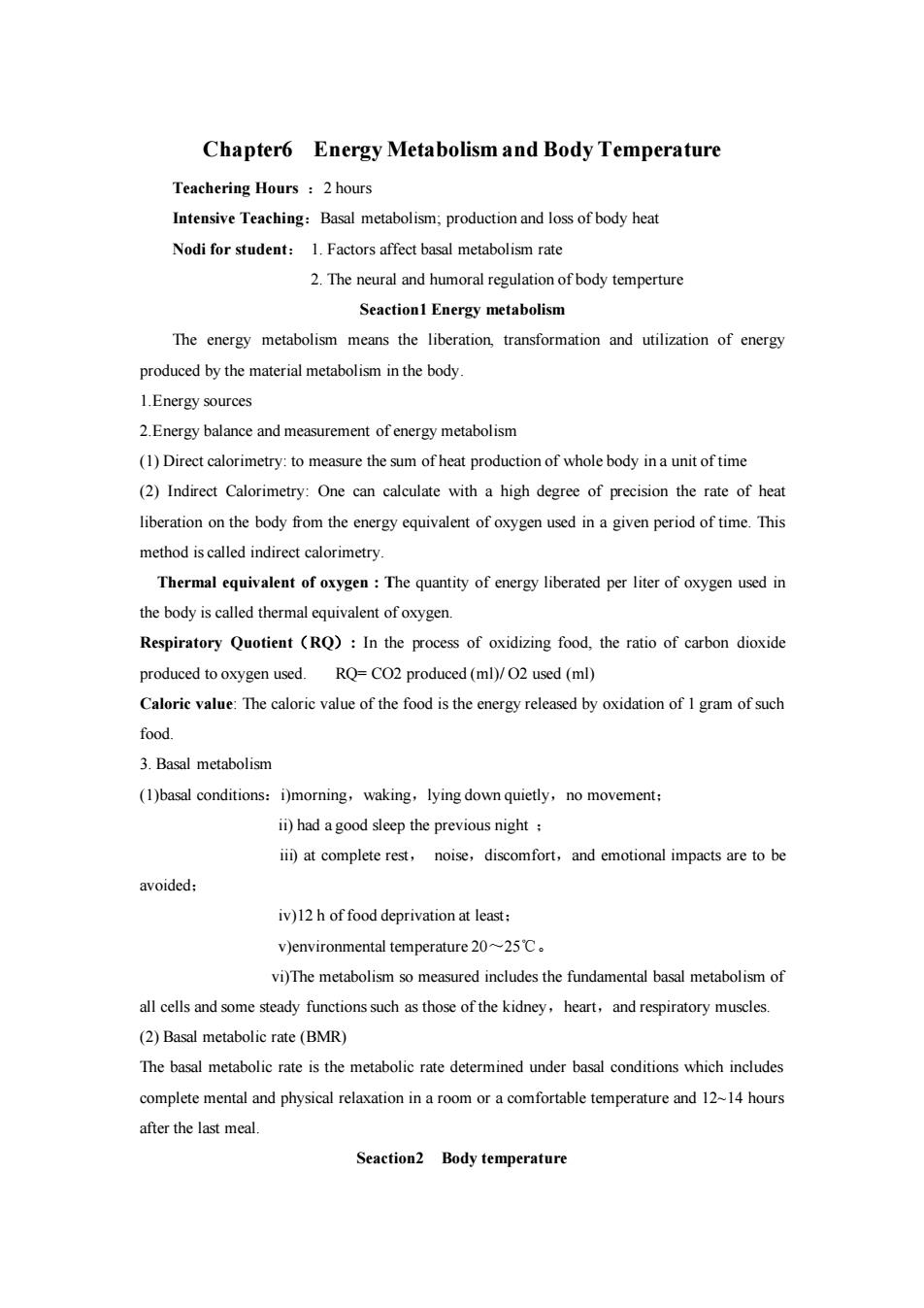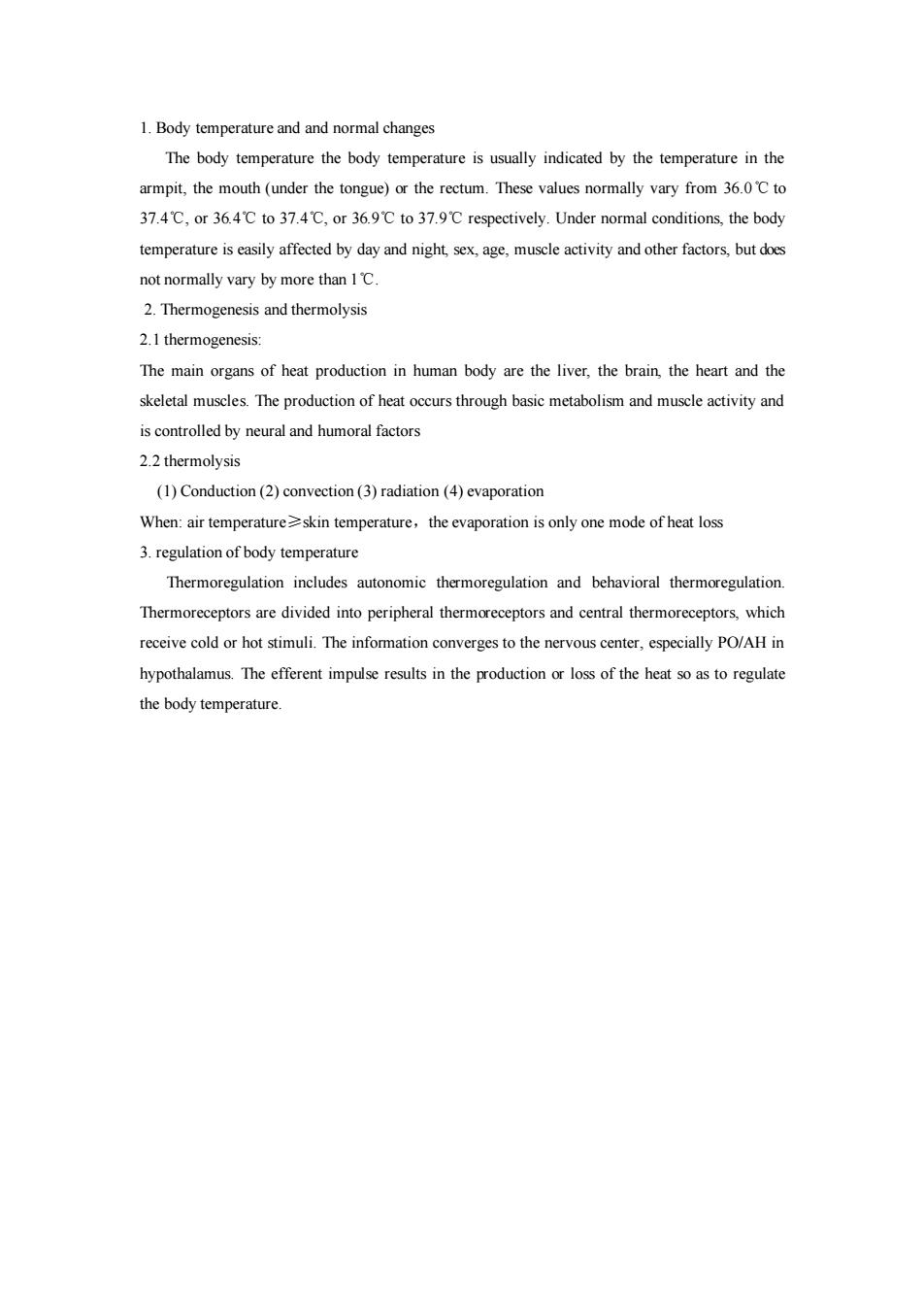
Chapter6 Energy Metabolism and Body Temperature Teachering Hours 2 hours Intensive Teaching:Basal metabolism;production and loss of body heat Nodi for student:1.Factors affect basal metabolism rate 2.The neural and humoral regulation of body temperture Seaction1 Energy metabolism The energy metabolism means the liberation,transformation and utilization of energy produced by the material metabolism in the body. 1.Energy sources 2.Energy balance and measurement of energy metabolism (1)Direct calorimetry:to measure the sum of heat production of whole body in a unit of time (2)Indirect Calorimetry:One can calculate with a high degree of precision the rate of heat liberation on the body from the energy equivalent of oxygen used in a given period of time.This method is called indirect calorimetry. Thermal equivalent of oxygen The quantity of energy liberated per liter of oxygen used in the body is called thermal equivalent of oxygen. Respiratory Quotient (RQ):In the process of oxidizing food,the ratio of carbon dioxide produced to oxygen used.RQ=CO2 produced(ml)/O2 used(ml) Caloric value:The caloric value of the food is the energy released by oxidation of 1 gram of such food. 3.Basal metabolism (1)basal conditions:i)morning,waking,lying down quietly,no movement; ii)had a good sleep the previous night iii)at complete rest,noise,discomfort,and emotional impacts are to be avoided: iv)12 h of food deprivation at least: v)environmental temperature 20~25C. vi)The metabolism so measured includes the fundamental basal metabolism of all cells and some steady functions such as those of the kidney,heart,and respiratory muscles. (2)Basal metabolic rate(BMR) The basal metabolic rate is the metabolic rate determined under basal conditions which includes complete mental and physical relaxation in a room or a comfortable temperature and 12~14 hours after the last meal. Seaction2 Body temperature
Chapter6 Energy Metabolism and Body Temperature Teachering Hours :2 hours Intensive Teaching:Basal metabolism; production and loss of body heat Nodi for student: 1. Factors affect basal metabolism rate 2. The neural and humoral regulation of body temperture Seaction1 Energy metabolism The energy metabolism means the liberation, transformation and utilization of energy produced by the material metabolism in the body. 1.Energy sources 2.Energy balance and measurement of energy metabolism (1) Direct calorimetry: to measure the sum of heat production of whole body in a unit of time (2) Indirect Calorimetry: One can calculate with a high degree of precision the rate of heat liberation on the body from the energy equivalent of oxygen used in a given period of time. This method is called indirect calorimetry. Thermal equivalent of oxygen : The quantity of energy liberated per liter of oxygen used in the body is called thermal equivalent of oxygen. Respiratory Quotient(RQ): In the process of oxidizing food, the ratio of carbon dioxide produced to oxygen used. RQ= CO2 produced (ml)/ O2 used (ml) Caloric value: The caloric value of the food is the energy released by oxidation of 1 gram of such food. 3. Basal metabolism (1)basal conditions:i)morning,waking,lying down quietly,no movement; ii) had a good sleep the previous night ; iii) at complete rest, noise,discomfort,and emotional impacts are to be avoided; iv)12 h of food deprivation at least; v)environmental temperature 20~25℃。 vi)The metabolism so measured includes the fundamental basal metabolism of all cells and some steady functions such as those of the kidney,heart,and respiratory muscles. (2) Basal metabolic rate (BMR) The basal metabolic rate is the metabolic rate determined under basal conditions which includes complete mental and physical relaxation in a room or a comfortable temperature and 12~14 hours after the last meal. Seaction2 Body temperature

1.Body temperature andand normal changes The body temperature the body temperature is usually indicated by the temperature in the armpit,the mouth(under the tongue)or the rectum.These values normally vary from 36.0C to 37.4℃,or36.4℃to37.4℃,or36.9℃to37.9℃respectively.Under normal conditions,the body temperature is easily affected by day and night,sex,age,muscle activity and other factors,but does not normally vary by more than IC. 2.Thermogenesis and thermolysis 2.1 thermogenesis: The main organs of heat production in human body are the liver,the brain,the heart and the skeletal muscles.The production of heat occurs through basic metabolism and muscle activity and is controlled by neural and humoral factors 2.2 thermolysis (1)Conduction(2)convection(3)radiation (4)evaporation When:air temperatureskin temperature,the evaporation is only one mode of heat loss 3.regulation of body temperature Thermoregulation includes autonomic thermoregulation and behavioral thermoregulation. Thermoreceptors are divided into peripheral thermoreceptors and central thermoreceptors,which receive cold or hot stimuli.The information converges to the nervous center,especially PO/AH in hypothalamus.The efferent impulse results in the production or loss of the heat so as to regulate the body temperature
1. Body temperature and and normal changes The body temperature the body temperature is usually indicated by the temperature in the armpit, the mouth (under the tongue) or the rectum. These values normally vary from 36.0℃ to 37.4℃, or 36.4℃ to 37.4℃, or 36.9℃ to 37.9℃ respectively. Under normal conditions, the body temperature is easily affected by day and night, sex, age, muscle activity and other factors, but does not normally vary by more than 1℃. 2. Thermogenesis and thermolysis 2.1 thermogenesis: The main organs of heat production in human body are the liver, the brain, the heart and the skeletal muscles. The production of heat occurs through basic metabolism and muscle activity and is controlled by neural and humoral factors 2.2 thermolysis (1) Conduction (2) convection (3) radiation (4) evaporation When: air temperature≥skin temperature,the evaporation is only one mode of heat loss 3. regulation of body temperature Thermoregulation includes autonomic thermoregulation and behavioral thermoregulation. Thermoreceptors are divided into peripheral thermoreceptors and central thermoreceptors, which receive cold or hot stimuli. The information converges to the nervous center, especially PO/AH in hypothalamus. The efferent impulse results in the production or loss of the heat so as to regulate the body temperature